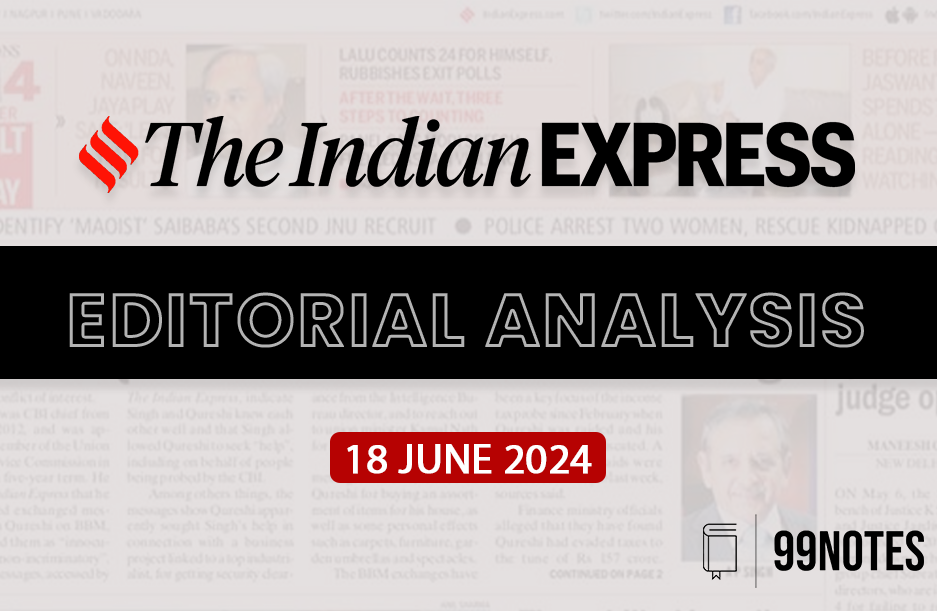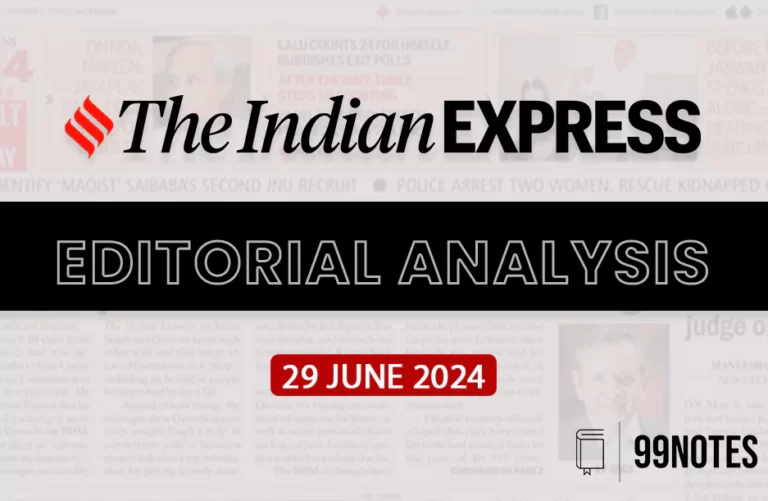18 June 2024 : Indian Express Editorial Analysis
1. Bharat’s way in the world
(Source: Indian Express; Section: The Editorial Page; Page: 08)
| Topic: GS2 – International Relations |
| Context: |
|
A New Role for India:
- This episodic Western romance with India is not entirely new, but this time it transcends the spiritual quests of past centuries. There is a newfound faith in India’s potential as a global leader—a friend, a family, a guru, and a protector.
- The critical question is whether India can rise to meet these heightened expectations. India must build the capacity to take on a new leadership role by drawing from its vast reservoir of ancient wisdom and adapting with alacrity, audacity, and flexibility.
- These strengths are essential for India to transform into a global mediator, a regional manager, and a mobilizer against the looming threat from China.
India’s Diplomatic Efforts:
- India’s diplomatic efforts have shown promise, particularly through the strategic interventions by Ajit Doval, India’s National Security Advisor.
- One notable instance was during the height of the Gaza violence in March, where India proposed a unilateral ceasefire during Ramadan to Israeli Prime Minister Benjamin Netanyahu.
- Although the proposal ultimately fell through due to a trust deficit among stakeholders, it demonstrated India’s willingness to engage meaningfully in complex international situations.
Strategic Autonomy and Influence:
- India’s strategic autonomy and reluctance to take sides hastily have provided it with the space and influence to suggest innovative ideas at the international level.
- This is evident from India’s efforts to foster relationships with key figures in Saudi Arabia and the UAE, organize ceasefire talks with Pakistan, and attempt mediation between Russia and Ukraine.
- These actions underline India’s growing stature and influence in global affairs.
Leveraging Indigenous Wisdom:
- For India to continue its ascent, Modi 3.0 must look beyond Western ideas and tap into indigenous wisdom from Indian traditions and scholars.
- The stilted bureaucracy and often shallow think tanks cannot provide the necessary support for new ideas.
- Instead, Modi’s administration should draw from the deep knowledge contained within India’s ancient texts and traditions, ensuring that this wisdom informs modern policy-making.
Stabilizing the Neighborhood:
- Historically, no country has achieved great-power status without ensuring stability and influence in its immediate neighborhood.
- India must prioritize securing peace and stability in South Asia as it steps into a global mediatory role.
- This involves addressing challenges and opportunities presented by neighboring countries with fresh ideas and dedicated envoys, particularly in dealing with a resurgent and troubling Pakistan.
The China Challenge:
- The rise of China presents a formidable challenge to the entire international system. India must build its domestic capabilities to counter this threat through an all-of-government approach.
- Additionally, India should position itself as a “mobilizer,” rallying regional and international partners to address the security concerns posed by China.
- This proactive stance is crucial for India to effectively navigate the complexities of the current global landscape.
Conclusion:
- India stands at a pivotal moment, with the potential to take on a significant leadership role in a fractured world.
- By leveraging its ancient wisdom, maintaining strategic autonomy, and proactively engaging in global diplomacy, India can meet the expectations placed upon it and contribute meaningfully to international stability and peace.
| Soft Power of India |
|
| Practice Question: Discuss the role of India in the contemporary global order as envisioned after Prime Minister Narendra Modi’s engagements at the G7 outreach summit. What strategic steps should India take to fulfill its potential as a global leader, mediator, and mobilizer? Illustrate your answer with relevant examples from recent Indian diplomatic efforts. (250 words/15 m) |
2. THE SHADOW OF CASTE
(Source: Indian Express; Section: The Editorial Page; Page: 08)
| Topic: GS2 – Social Justice – Vulnerable Section |
| Context: |
|
Disparities in Consumption Across Social Groups:
- In 2022-23, while STs accounted for 9% of the population, their consumption share was only 7%. Similarly, SCs, constituting 20% of the population, had a consumption share of 16%.
- The OBCs, representing 43% of the population, had a consumption share of 41%, indicating a relatively conservative consumption pattern within this group.
- The General category, making up 28% of the population, commanded a notably higher consumption share of 36%.
- These findings underscore the persistent disparities in consumption distribution across social groups. Despite minimal fluctuations over time, SCs and STs consistently lag behind the General and OBC categories.
What is the Gini Coefficient?
- The Gini Coefficient, often referred to as the Gini Index or Gini Ratio, is a measure of income or wealth inequality within a specific population, region, or country.
- It assigns a numerical value between 0 and 1.
- 0 represents perfect income or wealth equality (everyone has the same income or wealth), and 1 signifies perfect inequality (one person or household has all the income or wealth, and everyone else has none).
- To calculate the Gini Coefficient, income or wealth data is typically arranged in ascending order, from the poorest to the richest individuals or households.
- A Lorenz curve is plotted, which is a graphical representation of the actual income or wealth distribution. It compares the cumulative income or wealth of the population to the cumulative share of the population.
- The Gini Coefficient is calculated by measuring the area between the Lorenz curve and the line of perfect equality. This area is then divided by the total area under the line of perfect equality.
Changes in the Gini Coefficient:
- The overall Gini coefficient decreased from 0.359 in 2017-18 to 0.309 in 2022-23, indicating a reduction in overall income inequality by 0.050 points.
- The ST category saw its Gini coefficient decrease from 0.322 to 0.268, a 0.054 point drop, signaling an improvement in equitable consumption distribution within this community.
- Similarly, the SC category observed a decrease from 0.312 to 0.273. The OBC category witnessed a decline from 0.336 to 0.288, a 0.048 point decrease, while the General category experienced the most substantial reduction, from 0.379 to 0.306, amounting to a 0.073 point drop.
- This notable decrease could indicate various socioeconomic changes, including social mobility and effective policy interventions.
Underlying Economic Disparities:
- Despite these improvements, deeper analysis of consumption patterns reveals underlying economic disparities among India’s social groups, with ST and SC communities enduring the most pronounced discrepancies.
- For the bottom 20% decile of ST, SC, and OBC groups, there’s been a decrease in consumption levels from 2017-18 to 2022-23, albeit marginally.
- However, for the General category, the decrease in consumption levels is more pronounced, indicating a relative decline in consumption among the poorest segment of the general population.
Concentration of Wealth Among Elites:
- Conversely, consumption has slightly increased for all social groups in the top 20% decile, with the General category experiencing a significant 10 percentage points surge between the two periods.
- This disproportionate rise among the wealthiest segment of the General category implies a potential concentration of wealth among high-caste elites.
- Consequently, the disparity between the General category and other social groups remains significant, underscoring persistent discrepancies in consumption patterns.
Addressing Persistent Inequality:
- India has made remarkable strides in lifting millions out of multidimensional poverty, yet inequality among various caste groups persists. Despite the Constitution’s abolition of caste discrimination and the implementation of affirmative action programs, caste continues to shape economic realities.
- The Centre has enacted numerous policies to mitigate these disparities, including reservation, rural development initiatives, and direct benefit transfers. While these measures have yielded some progress, substantial challenges remain.
Policy Recommendations:
- Disparities in consumption patterns among different socioeconomic groups reflect potential disparities in income, access to resources, or purchasing power.
- Efforts should focus on augmenting income generation and consumption abilities among the lower deciles, particularly within the ST and SC communities. This is crucial for fostering social harmony and economic stability across society.
- Continued monitoring of trends and targeted interventions addressing specific socioeconomic challenges faced by different groups are necessary to ensure sustained progress towards greater economic equity.
| Practice Question: Discuss the impact of caste-based inequalities on economic inequality in India, as highlighted by recent data from the World Inequality Lab. What policy interventions are necessary to address these disparities and promote economic equity? (250 words/15 m) |





